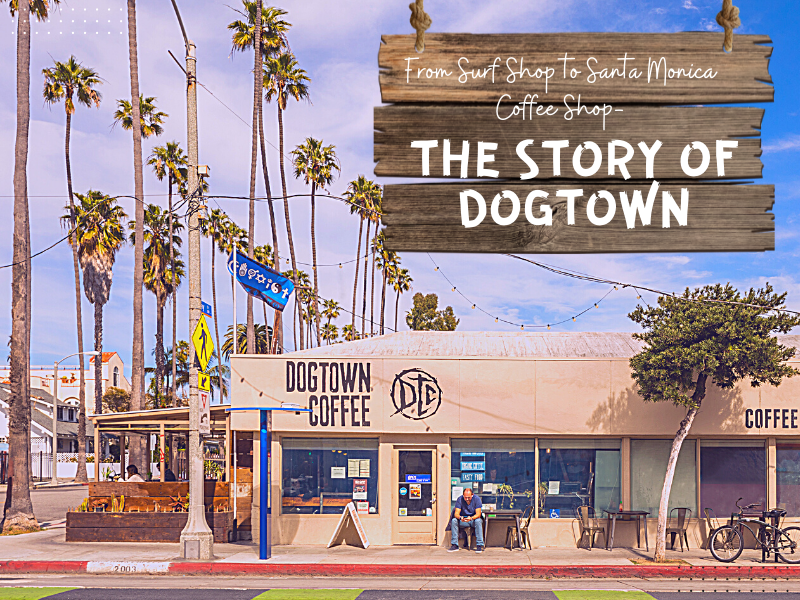Dogtown. One simple word yet its cultural significance to Santa Monica is undeniable. After all, we can still experience the impact it has had on our community to this day. Just follow its decades-old roots to its origins and you’ll recognize the kind of bold attitudes and inventive personalities the spirit of Dogtown has helped foster throughout the years. In honor of Dogtown’s incredible influence, as well as DTC’s (almost) 10-year anniversary, we’d like to pay homage to our namesake by retelling its one-of-a-kind story. So, from surf and skate hangout to Santa Monica coffee shop, here’s how Dogtown became the space we all know and love today.

The 1950s And 1960s
Surfing has always been an integral part of Southern California history, but the 50s and 60s were quite a unique period for this sport. At this time, surfing had reached its peak popularity, yet surfers were often ostracized and treated as outsiders by those that didn’t understand its appeal. But these surfers didn’t care, and it definitely didn’t discourage them from hanging up their boards. Instead, something more inspiring happened. In the face of rejection, these outcasts persevered. They bonded together and formed their own small community they dubbed Dogtown, a space covering stretches of Santa Monica and Venice, where they were never ridiculed or shamed for their passion. And most importantly, they kept surfing.
The Cove
By the early 1970s, these ties among surfers grew even stronger thanks to the establishment of The Cove. Once a popular seaside amusement park named Pacific Ocean Pier Park, it had been abandoned and essentially left for dead. Fortunately for surfers, the dilapidated wooden beams in the water had constructed the perfect, discreet spot to ride waves without onlookers bothering their practice. It was dubbed The Cove and became the most exclusive place to surf. You had to be invited to hang out at The Cove and let’s just say these surfers weren’t handing out welcomes to just anyone.
Zephyr Surf Shop And Jeff Ho Productions
It was around this same time that Zephyr had officially stepped on the scene, located right smack in the middle of Dogtown. Founded by Jeff Ho, Skip Engblom, and Craig Stecyk, this shop was revolutionary for the world of surfing. They sold surfboards that were handcrafted by the boys themselves, but these boards were unlike anything else the surf community had seen before. These pioneers wanted to push the envelope of design, and they did exactly that by optimizing the function and aesthetics of the traditional surfboard. But maybe the best part about Zephyrs surfboards is that they directly reflected the local area. Long gone we’re the generic designs, now replaced by Venice and Santa Monica-based art that tied surfers to their community and directly represented their hometown.
But Zephyr was more than a surf shop. It was also a team of surfers. A collective of young people who were nobodies at the time. Fresh to surfing yet eager to prove their skills and make a name for themselves. Zephyr was their refuge. They all worked at the surf shop during their downtime, but when the waves were high, they were at The Cove. These kids lived and breathed surfing, it consumed their lives. Even when the waters weren’t suitable to surf, they found a way to bypass this so they could keep practicing their surf skills, and that’s where skating came into the picture.
Californian Drought And The Skate Revolution
When a drought-hit California, abandoned pools became the norm in Santa Monica and Venice. They were an eyesore to most, but Zephyr saw gold. The curved concrete edges of the pools mimicked formations similar to ocean waves. It was the perfect opportunity to keep flexing their surfer muscles, even when the weather wouldn’t permit. Zephyr would soon sneak into empty lots with pools and use their boards to skate around the sides. Eventually, other surfers caught wind of their unorthodox practice, they became enthralled by the pure skill and raw talent of the Z-Boys, often trying to replicate their methods on their own. It was at this moment that skating transformed into the style we see today. In fact, we see skaters all the time using ramps and inclines to flip their boards and catch air-time, but the Z-Boys were quite literally the first ones to ever actually perform these tricks at all, coining the term vert skateboarding to describe their original style. They single-handedly influenced the scene in the long run, brought life to a dying sport, and ushered in a new generation of skaters, an impressive feat if we do say so ourselves.
Dogtown Coffee
Zephyr surf shop and Jeff Ho productions have long since closed their doors. But in 2007, the space was declared a city landmark by Santa Monica. Today, that same building is now Dogtown Coffee, a Santa Monica breakfast and coffee shop. We might not sell surfboards, but we pride ourselves on being a reflection of Santa Monica’s rich surf and skate history. We’re happy to do our part to keep these legends alive, which is why so much of us, from our artwork, ethos, and style, is a direct nod to our predecessors. These trailblazers have done so much to shape our community- the least we could do is keep telling their story and reminding everyone where the famous resilient Santa Monica spirit started.
We welcome all to visit our Santa Monica coffee shop and immerse themselves in the essence of Dogtown. Its energy is inspiring. Refreshing. That’s why we often host events to encourage the community to come down and revel in the atmosphere, like live performances and new delicious items to keep our menu exciting- and we hope the next time you pass by DTC, you’ll come on in to experience the magic of Dogtown for yourself too.
This blog is brought to you by Dogtown Coffee, home of the Salty Dog, one of Santa Monica’s favorite coffees.

